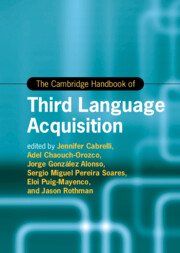Book contents
- The Cambridge Handbook of Third Language Acquisition
- Cambridge Handbooks in Language and Linguistics
- The Cambridge Handbook of Third Language Acquisition
- Copyright page
- Contents
- Figures
- Tables
- Contributors
- Introduction Multilingualism
- Part I Theoretical Approaches to L3/Ln
- Part II L3/Ln across Linguistic Domains
- Part III Becoming and Staying Multilingual at Different Ages
- Part IV L3/Ln in Action
- 16 Theoretical Linguistic Approaches to Multilingual Code-Switching
- 17 Psycholinguistics of Multilingual Code-Switching
- 18 Third Language Acquisition in the Classroom
- 19 Diversity in Multilingual Learners
- Part V L3/Ln and Cognition
- Part VI Research Methods in L3/Ln
- Index
- References
19 - Diversity in Multilingual Learners
How Variation in Learners and Contexts for Learning Shape the Acquisition and Processing of an L3/Ln
from Part IV - L3/Ln in Action
Published online by Cambridge University Press: 13 July 2023
- The Cambridge Handbook of Third Language Acquisition
- Cambridge Handbooks in Language and Linguistics
- The Cambridge Handbook of Third Language Acquisition
- Copyright page
- Contents
- Figures
- Tables
- Contributors
- Introduction Multilingualism
- Part I Theoretical Approaches to L3/Ln
- Part II L3/Ln across Linguistic Domains
- Part III Becoming and Staying Multilingual at Different Ages
- Part IV L3/Ln in Action
- 16 Theoretical Linguistic Approaches to Multilingual Code-Switching
- 17 Psycholinguistics of Multilingual Code-Switching
- 18 Third Language Acquisition in the Classroom
- 19 Diversity in Multilingual Learners
- Part V L3/Ln and Cognition
- Part VI Research Methods in L3/Ln
- Index
- References
Summary
In this chapter we review current research on how the experiences that multilingual learners bring to language learning may shape the trajectory and outcome of learning an L3/Ln. While there is abundant evidence that the particular languages that individuals speak contribute to the process of new language learning, and evidence that multilingualism may enhance new learning, there is now emerging research demonstrating that the cognitive and neural mechanisms that enable bilinguals and multilinguals to use two or more languages effectively may also contribute to the course and consequences of new language learning. The dynamic activation of all of the languages that a speaker uses and interactions across languages shape not only language processing but also new learning. We identify sources of variation among learners and across the contexts in which learning occurs to consider how language learning might reflect multilingual experience.
- Type
- Chapter
- Information
- The Cambridge Handbook of Third Language Acquisition , pp. 492 - 516Publisher: Cambridge University PressPrint publication year: 2023

